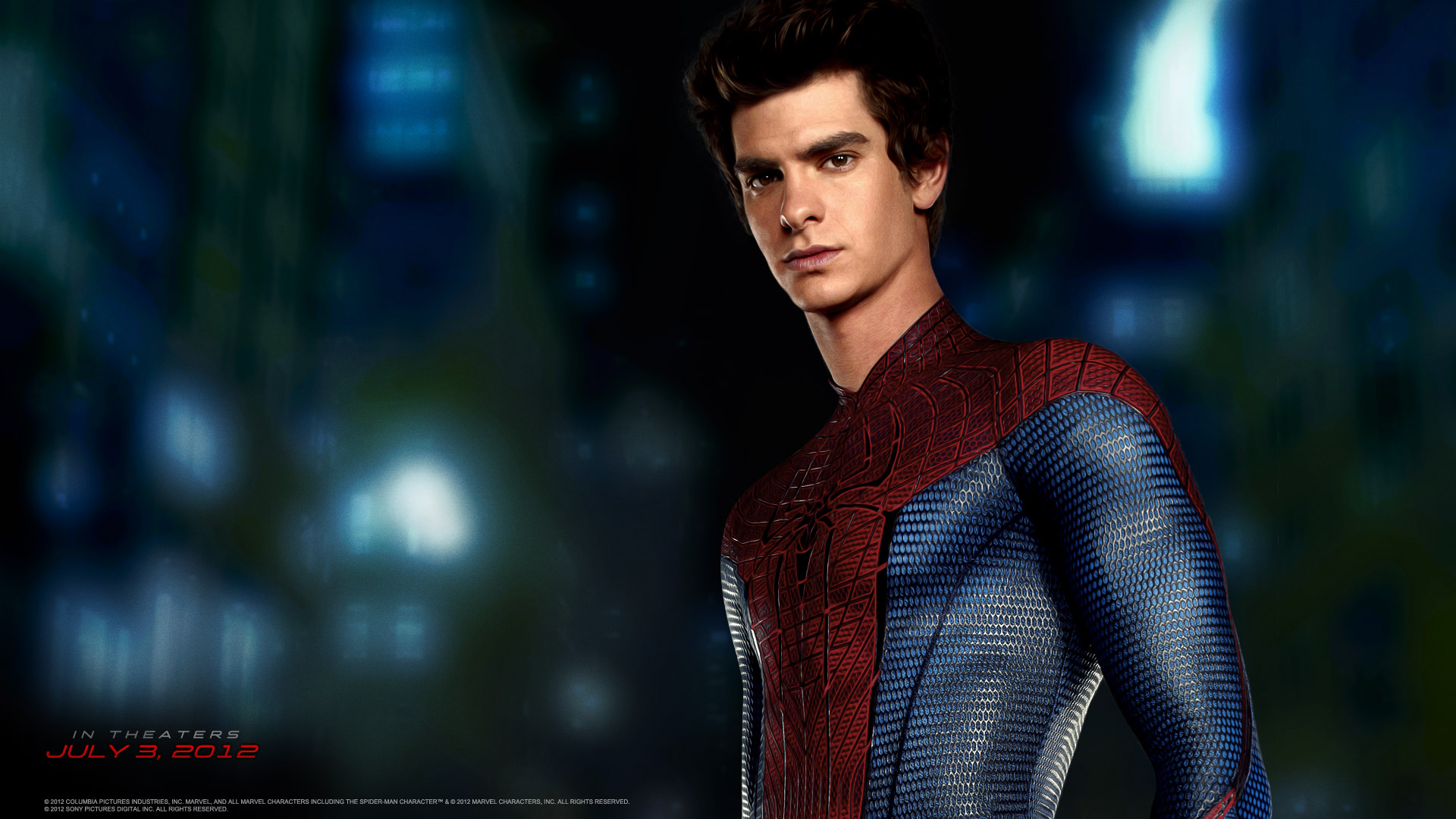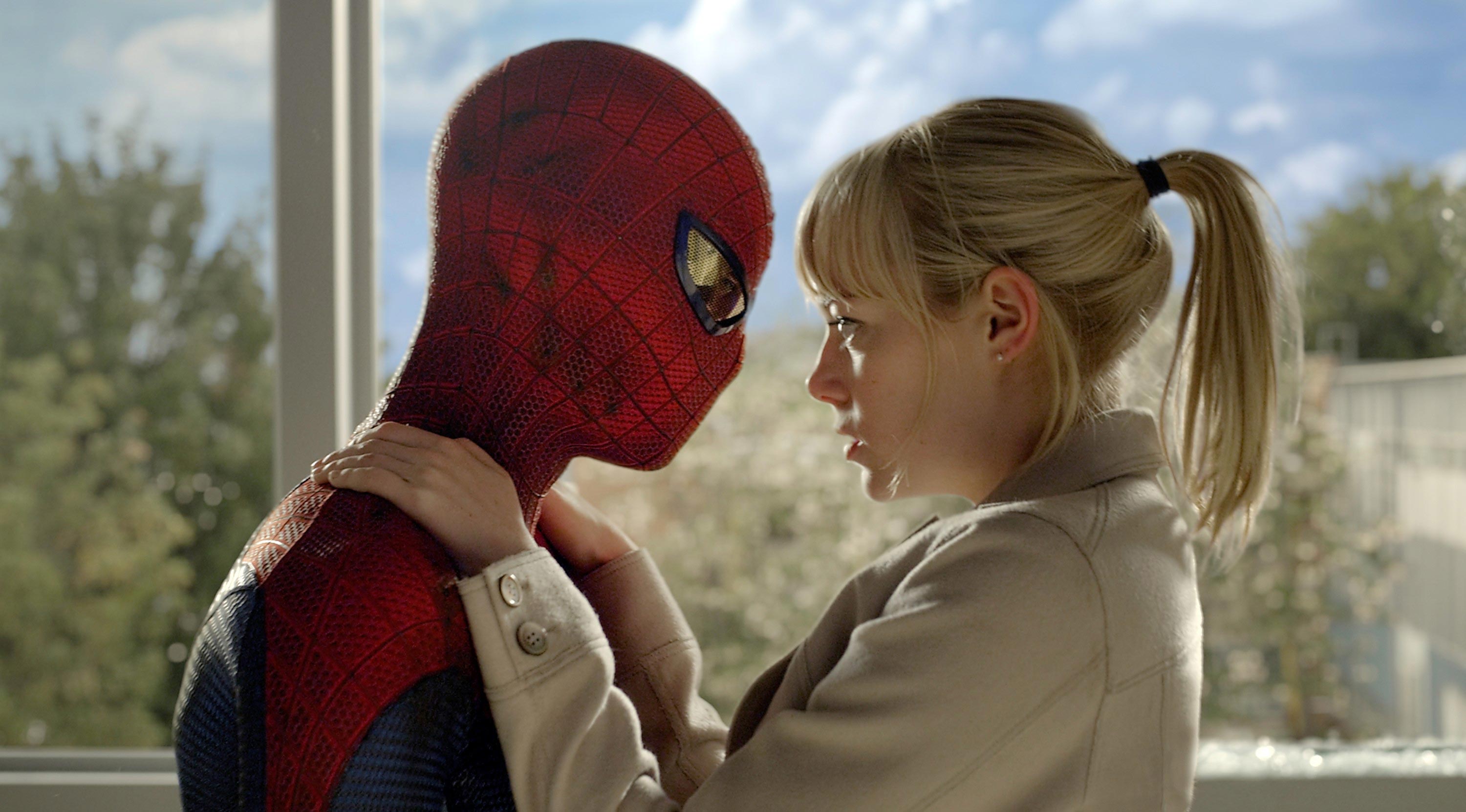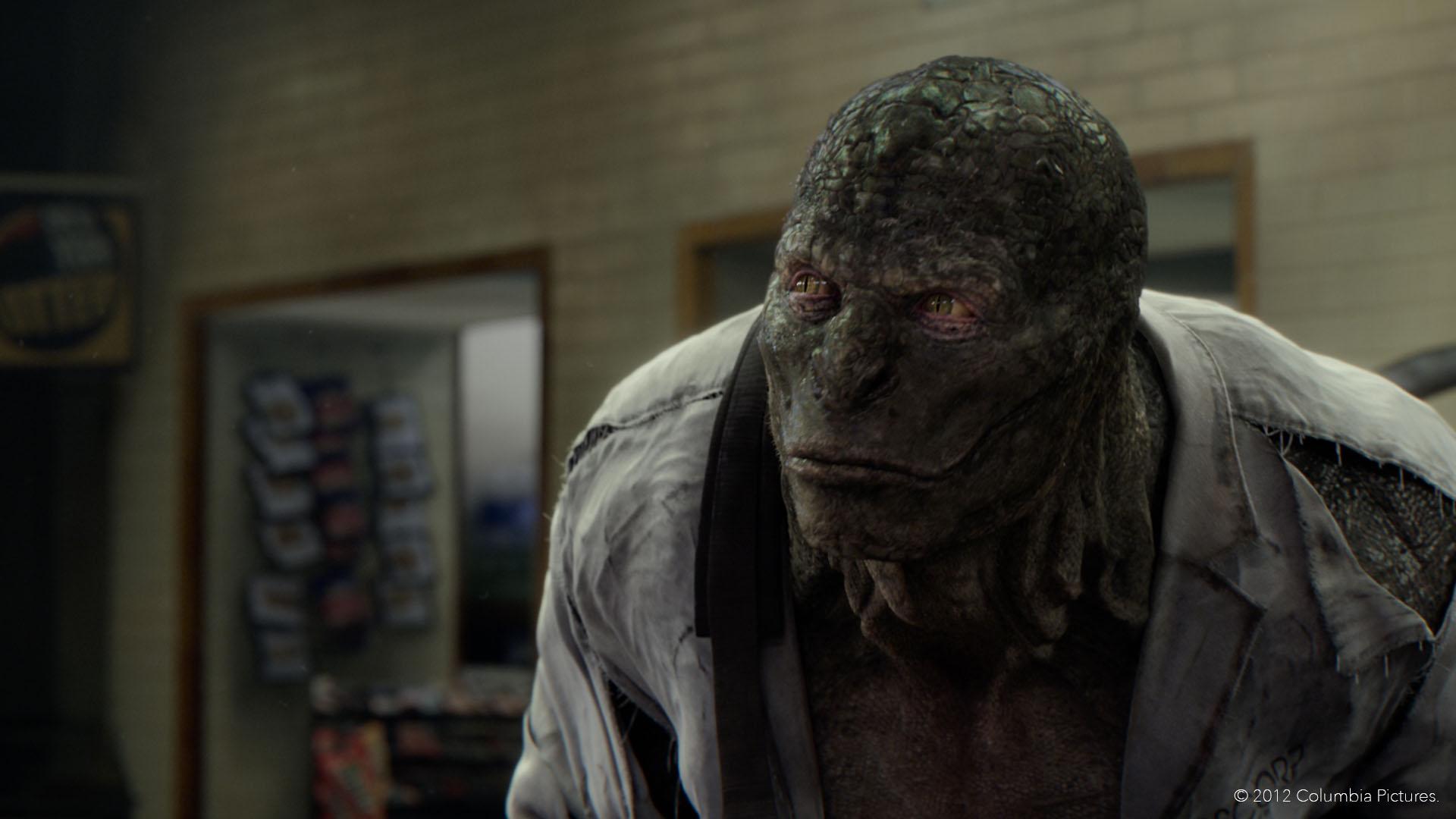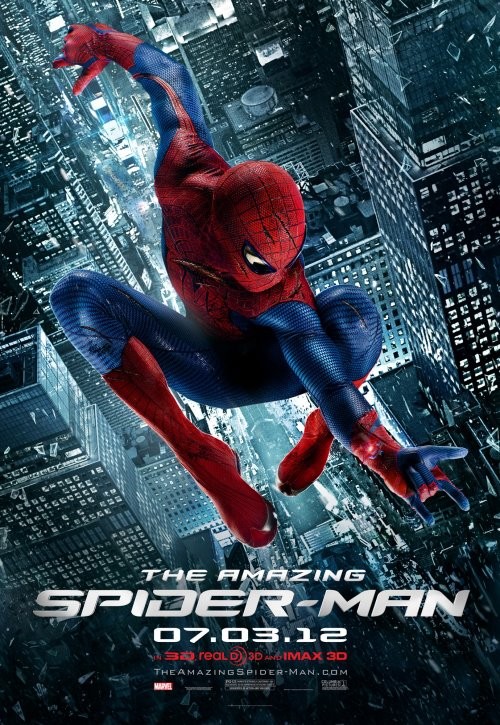USA. 2012.
Crew
Director – Marc Webb, Screenplay – Steve Kloves, Alvin Sargent & James Vanderbilt, Story – James Vanderbilt, Based on the Comic-Book Created by Steve Ditko & Stan Lee, Producers – Avi Arad, Matthew Tomlach & Laura Ziskin, Photography (3D) – John Schwartzman, Music – James Horner, Visual Effects Supervisor – Jerome Chen, Visual Effects – Method Studio, Pixel Playground, Pixomondo (Supervisor – Boris Schmidt) & Sony Pictures Imageworks, Special Effects Supervisor – John Frazier, Costume Effects – Legacy Effects (Supervisors – Shane Mahan & Lindsay McGowan), Production Design – J. Michael Riva. Production Company – Marvel Enterprises/Columbia/Laura Ziskin Productions.
Cast
Andrew Garfield (Peter Parker/Spider-Man), Emma Stone (Gwen Stacy), Rhys Ifans (Dr Curtis Connors/The Lizard), Denis Leary (Captain George Stacy), Martin Sheen (Uncle Ben), Sally Field (Aunt May), Irrfan Khan (Rajit Ratha), Chris Zylka (Flash Thompson), Campbell Scott (Richard Parker), C. Thomas Howell (Jack’s Father), Max Charles (Peter Parker Age 4), Jake Ryan Keiffer (Jack), Kari Coleman (Helen Stacy), Embeth Davidtz (Mary Parker)
Plot
As a child, Peter Parker is left by his parents in the care of his Uncle Ben and Aunt May. At school in his teens, he has a crush on classmate Gwen Stacy, while he is also regarded as a nerd and bullied by Flash Thompson. In the basement, Peter finds his father’s satchel and documents hidden inside it. This makes him curious about his father’s colleague Dr Curt Connors, an employee of Oscorp and an expert on cross-species genetics. Peter contrives to sneak inside Connors’ laboratory during an internship tour and enters a room where genetically-engineered spiders are spinning webs. Unseen, one of the spiders gets down the back of Peter’s shirt and bites him. Afterwards Peter finds that he has heightened senses, agility and strength. Uncle Ben is then shot by a fleeing armed robber. A devastated Peter starts searching the streets for the killer, using his newfound spider abilities to apprehend thugs. After this gains headlines, Peter creates a masked costume to hide his identity, as well as builds wristbands that shoot high-tensile webbing develop by Oscorp on which to swing. He calls himself Spider-Man. Peter befriends Connors and gives him his father’s papers, which Connors uses to perfect a regeneration formula he has been working on. Under pressure to conduct human trials before funding is cut, Connors injects himself with the formula. This causes his severed arm to regenerate but also turns him into a lizard-like creature. He and Spider-Man end up fighting as Connors goes amok on a bridge in lizard form. Meanwhile, Gwen’s father police captain George Stacy regards Spider-Man as a dangerous vigilante and issues an arrest warrant. Peter chooses to reveal his identity as Spider-Man to Gwen. Meanwhile, Connors, driven crazy by repeated over-exposure to the drug, has discovered that Peter is Spider-Man and comes after him.
Marvel Comics adaptations are massive in the 00s. There have been the huge success of adaptations of Blade (1998), X-Men (2000), Daredevil (2003), Hulk (2003), The Punisher (2004), Elektra (2005), Fantastic Four (2005), Ghost Rider (2007), Iron Man (2008), Captain America: The First Avenger (2011), Thor (2011), The Avengers (2012), Guardians of the Galaxy (2014), Ant-Man (2015), Deadpool (2016), Doctor Strange (2016), Black Panther (2018), Venom (2018), Captain Marvel (2019), Black Widow (2021), Eternals (2021), Shang-Chi and the Legend of the Ten Rings (2021), The Fantastic 4: First Steps (2025) and Thunderbolts* (2025) and various sequels to these, as well as the tv series’ Agents of S.H.I.E.L.D. (2013-20), Daredevil (2015-8), Agent Carter (2015-6), Jessica Jones (2015-9), Luke Cage (2016-8), The Defenders (2017), Inhumans (2017), Iron Fist (2017-8), The Punisher (2017-9), Runaways (2017-9), The Falcon and the Winter Soldier (2021- ), Hawkeye (2021), Loki (2021- ), WandaVision (2021), Moon Knight (2022- ), Ms Marvel (2022), She-Hulk: Attorney at Law (2022- ) and Secret Invasion (2023). Each of the films has risen to enter the field at the top of the box-office.
Spider-Man is Marvel Comics’ most popular character on the comic-book page. The character has appeared on the screen before. There was a dreary tv series The Amazing Spiderman (1977-9) starring Nicholas Hammond, which only lasted for one season. The show’s pilot was released internationally in theatres as Spider-Man (1977) and was followed by two further cinematic releases, Spider-Man Strikes Back (1979) and Spiderman and the Dragon’s Challenge (1980), recut from episodes of the tv series. There have also been three different animated tv series. During the 1990s, a film version of Spider-Man underwent a complicated legal entanglement with people as at opposite ends of the spectrum as schlockmeister Albert Pyun and James Cameron being announced to direct at various points. With the renewed interest in Marvel film properties in the 00s, Spiderman finally emerged as the hugely successful Spider-Man (2002) starring Tobey Maguire and directed by Sam Raimi. Raimi and Maguire went onto two further films with Spider-Man 2 (2004) and Spider-Man 3 (2007).
The Amazing Spider-Man started life as Spider-Man 4 where Sam Raimi, Tobey Maguire and various other regulars were inveigled back. Raimi departed in 2010 after dissatisfaction with the script and most of the other key figures walked with him. Spider-Man 4 was then announced as a reboot and after various high-profile names were considered, the central role went to Andrew Garfield. The director was announced as Marc Webb, a former music video specialist who had previously made his feature film debut with the acclaimed (500) Days of Summer (2009) and subsequent to this the live-action remake of Disney’s Snow White (2025). The new script comes from Alvin Sargent who worked on the other Spider-Man films, Harry Potter series regular Steve Kloves and James Vanderbilt, writer of Zodiac (2007) and The Losers (2010).
The term reboot is waved around by studio publicity machines nowadays to the point that it has become meaningless. GoldenEye (1995) and Casino Royale (2006) were both reboots of the James Bond franchise that cast new actors and offered dramatic reconceptions of the character. Batman Begins (2005) was a reboot of the Batman movie franchise after it had been ground into the dust by bad sequels. Both Star Trek (2009) and X: First Class (2011) were attempts to redo the familiar series with younger faces.

A reboot should be an attempt to revive a series and revise what has gone before. Now it seems to be a term thrown around every time a series undergoes a change of lead actor or director. The Fantastic Four series was rebooted shortly after with Fantastic Four (2015), even though it has only put out two films. There is debate as Christopher Nolan delivers The Dark Knight Rises (2012) that the Batman film series will now have to undergo a reboot just because it changes its principal creative force.
To me, this is devaluing the meaning of the term. What is simply wrong with making another film in the series, why does it have to be branded as an entire reconception every time it recasts the central parts? By this thinking, the Tarzan films would have had to undergone more than thirty reboots and the James Bond series six of them. Not to mention, given that most film series are turning out about one film every three years, it means the tedium of seeing the origin story retold at least once a decade.
The term reboot has been so devalued that one is not really sure what they are about to see when they sit down to watch The Amazing Spider-Man. We see Peter Parker in high school and wonder if this is a prelude to setting up some story that would fit in between the events of the Raimi/Maguire films but it then becomes apparent that Peter is not yet Spider-Man. The film then proceeds to spend the better part of an hour redoing what was already told at the start of the 2002 Spider-Man – Peter getting bitten by the mutant spider, discovering his superpowers, the death of Uncle Ben, his putting on the Spider-Man suit. These are similar to what we saw in Spider-Man but different in many ways.
One of the confusions about The Amazing Spider-Man is the lack of many of the regular characters. There is no Mary Jane Watson; instead, the love interest is Gwen Stacy – although this is following with comic-book canon in that Gwen was Peter’s girlfriend before Mary Jane came along. (Gwen had previously turned up in Spider-Man 3 played by Bryce Dallas Howard). There is no J. Jonah Jameson and Peter is now a student in high school, rather than the adult photographer he was in the Raimi films.

This is not unakin to what Christopher Nolan did with Batman Begins by taking the characters from the previous film incarnations back closer to the comic-book origin. There are comic-book elements reintroduced that we never saw in the other films – Peter shooting the webbing from wristbands rather than from out of his body as the Raimi films gave the impression he did, while Andrew Garfield’s behaviour is more spider-like and Marc Webb finds ways to depict the spider-sense, which Raimi never concerned himself with. Like Batman Begins, there is the sense that much is being held back in order to set up story arcs for successive sequels – such as what happened to Peter’s parents; we being left to wait for the implied introduction of Mary Jane and J. Jonah Jameson; as well as the by now de rigeur post-credits sequence for a Marvel film in which Connors finds he is sharing a cell with a mystery figure who is never identified but is supposed to be Norman Osborn (who becomes the Green Goblin).
With initial confusion over what the story was doing out of the way, even a resignation to the unnecessariness of a reboot, I began to enjoy what The Amazing Spider-Man was doing. In fact, I would have to say that I enjoyed it far more as a Spider-Man origin story than I did Sam Raimi’s telling of the same in Spider-Man. There Tobey Maguire played Peter Parker as an earnest boy scout who seemed to smile with a goofy wet-behind-the-ears innocence. Raimi’s approach seemed fuelled by the same winsome innocence and an earnest belief in decency, goodness and a world where Aunt May said her prayers before going to bed. By contrast, Marc Webb darkens Raimi’s vision. The colour tone of the film is a good deal more muted (even more so in 3D) – much of the film takes place at night whereas Raimi’s films were mostly bright and daylit. The characters seem a little less black-and-white (without quite descending to Batman level grimness). It gives an edge to the film.
The film gets an enormous boost in this department from Andrew Garfield. Garfield has been a rising name over the last few years, not being noticed much in roles in films such as The Imaginarium of Doctor Parnassus (2009) and Never Let Me Go (2010), even episodes of Doctor Who (2005– ), until his breakout performance as Eduardo Saverin in The Social Network (2010). Garfield despatches with Tobey Maguire’s gloopy characterisation and gives us Peter Parker as a nerd who puts on and then removes a pair of glasses to reveal a handsomeness (one that is going to have Andrew Garfield’s name going stellar one predicts). Garfield also gives Spider-Man with an undeniable sense of humour – there is an hilarious scene with he tossing one-liners and webbing at a car thief with equal rapidity (the only disappointment is that the film never visits this kind of wit again). Garfield gets to run a considerable emotional range as Peter and Marc Webb seems perfectly in tune with the character’s journey. Similarly, Emma Stone performs Gwen with just the right degree of girl next door lusciousness balanced out with a warm wit.

Where The Amazing Spider-Man works well is in giving Spiderman a new origin story, taking it away from Sam Raimi’s boy scout interpretation into something a little edgier and more realistically grounded. Where it works less effectively is when it comes to some of the other things that Raimi did well through the progression of his trilogy. The special effects are kept low key. Where Sam Raimi aimed for often epic-sized effects spectacle, Marc Webb prefers character. When Andrew Garfield goes into action, you feel less like it is a film wheeling out the mechanics of the superhero genre once again than a character who is reacting to troubled emotions and trying to figure out things for himself. This film mostly holds back on the spectacle until the climactic battle over the skies of Manhattan between Spider-Man and The Lizard. That said, Marc Webb also gets some fine, vertigo-inducing shots as Peter dives off the sides of buildings – even point-of-view shots of him swinging on the end of a web – that look amazing under the 3D camera.
It is usually the role of a sequel in a superhero series to keep upping the number of super-villains. Most sequels when they get to at least the second and certainly the third entry feature two, if not more, super-villains – a trend that began with Batman Returns (1992) and went absurd with Batman Forever (1995). One has gotten so used to this by now that it is a surprise that The Amazing Spider-Man only opts for a single villain – Curt Connors aka The Lizard. Unfortunately for the film, The Lizard is not a particularly interesting villain. Take Spider-Man out of the story and all that you would be left with would be a formulaic mad scientist/monster movie made for the Syfy Channel. The special effects for the lizard transformation and amok are nothing particularly special. Still, The Amazing Spider-Man is a good start and one looks forward to more from this particular take on the comic-book.
Andrew Garfield, Emma Stone and Marc Webb returned with a sequel The Amazing Spider-Man 2 (2014). With the box-office disappointment of the latter, we then received yet another reboot of the series that goes back to Peter Parker’s high school years with Spider-Man: Homecoming (2017), Spider-Man: Far from Home (2019) and Spider-Man: No Way Home (2021), featuring Tom Holland. The latter also features a reappearance from Andrew Garfield and Rhys Ifans as The Lizard. Holland’s Spider-Man also merged with the Marvel Cinematic Universe in Captain America: Civil War (2016), Avengers: Infinity War (2018) and Avengers: Endgame (2019). In addition, there was also the animated Spider-Man: Into the Spider-Verse (2018) and Spider-Man: Across the Spider-Verse (2023). Venom (2018) and its sequel Venom: Let There Be Carnage (2021), while Morbius (2022), Kraven the Hunter (2024) and Madame Web (2024) were further spinoffs of the Spider-Man universe.
(Nominee for Best Actor (Andrew Garfield) at this site’s Best of 2012 Awards).
Trailer here


